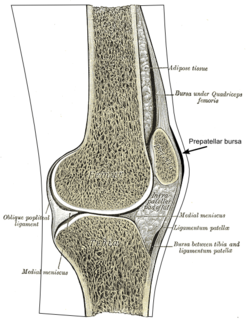 W
WA disease is a particular abnormal condition that negatively affects the structure or function of all or part of an organism, and that is not due to any immediate external injury. Diseases are often known to be medical conditions that are associated with specific symptoms and signs. A disease may be caused by external factors such as pathogens or by internal dysfunctions. For example, internal dysfunctions of the immune system can produce a variety of different diseases, including various forms of immunodeficiency, hypersensitivity, allergies and autoimmune disorders.
 W
WThe HFE H63D is a single-nucleotide polymorphism in the HFE gene, which results the substitution of aspartic acid for histidine at amino acid position 63 of the HPE protein (p.His63Asp). The protein participates in the regulation of iron absorption.
 W
WInfrapatellar fat pad syndrome, also known as Hoffa's disease, is when pain in the front of the knee occurs due to problems with the infrapatellar fat pad. Pain is generally just below the kneecap. Symptoms may worsen if the knee is overly straightened or bent for too long a period. Complications may include an inability to fully straighten the knee.
 W
WLightwood's law is the principle that, in medicine, bacterial infections will tend to localise while viral infections will tend to spread. This is based on the observation that while bacterial sepsis tends, despite affecting the whole body, to have a clear site of origin or 'focus', the opposite may be true of viral infections. There may be multiple sites across the body which are affected including dermatological manifestations, respiratory symptoms and gastrointestinal symptoms.
 W
WMultifactorial diseases are not confined to any specific pattern of single gene inheritance and are likely to be associated with multiple genes effects together with the effects of environmental factors.
 W
WA non-communicable disease (NCD) is a disease that is not transmissible directly from one person to another. NCDs include Parkinson's disease, autoimmune diseases, strokes, most heart diseases, most cancers, diabetes, chronic kidney disease, osteoarthritis, osteoporosis, Alzheimer's disease, cataracts, and others. NCDs may be chronic or acute. Most are non-infectious, although there are some non-communicable infectious diseases, such as parasitic diseases in which the parasite's life cycle does not include direct host-to-host transmission.
 W
WOld age refers to ages nearing or surpassing the life expectancy of human beings, and is thus the end of the human life cycle. Terms and euphemisms include old people, the elderly, OAPs, seniors, senior citizens, older adults, and the elders.
 W
WT-cell lymphoma is a rare form of cancerous lymphoma affecting T-cells. Lymphoma arises mainly from the uncontrolled proliferation of T-cells and can become cancerous.
 W
WWaardenburg Syndrome Type 1 is a congenital disorder that caused by a mutation in the PAX3 gene that results in abnormal development in the neural crest during early development. Type 1 results in early graying and white forelock and a notable distance between the eyes, noted as dystopia canthorum. Common symptoms of the disease also includes non-progressive hearing loss in majority of patients with Type 1. Patients can display complete or partial heterochromia and hypoplastic blue irides and congenital leukemia.